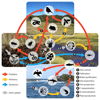Energy Flux: The Link between Multitrophic Biodiversity and Ecosystem Functioning
- PMID: 29325921
- PMCID: PMC6181201
- DOI: 10.1016/j.tree.2017.12.007
Energy Flux: The Link between Multitrophic Biodiversity and Ecosystem Functioning
Abstract
Relating biodiversity to ecosystem functioning in natural communities has become a paramount challenge as links between trophic complexity and multiple ecosystem functions become increasingly apparent. Yet, there is still no generalised approach to address such complexity in biodiversity-ecosystem functioning (BEF) studies. Energy flux dynamics in ecological networks provide the theoretical underpinning of multitrophic BEF relationships. Accordingly, we propose the quantification of energy fluxes in food webs as a powerful, universal tool for understanding ecosystem functioning in multitrophic systems spanning different ecological scales. Although the concept of energy flux in food webs is not novel, its application to BEF research remains virtually untapped, providing a framework to foster new discoveries into the determinants of ecosystem functioning in complex systems.
Keywords: ecological stoichiometry; ecosystem multifunctionality; food web; interaction network; metabolic theory; trophic cascade.
Copyright © 2017 Elsevier Ltd. All rights reserved.
Figures




References
-
- Butchart SHM, et al. Global biodiversity: indicators of recent declines. Science. 2010;328:1164–1168. - PubMed
-
- Cardinale BJ, et al. Biodiversity loss and its impact on humanity. Nature. 2012;486:59–67. - PubMed
-
- Mulder C, et al. 10 years later: revisiting priorities for science and society a decade after the millennium ecosystem assessment. Adv Ecol Res. 2015;53:1–53.
-
- Isbell F, et al. High plant diversity is needed to maintain ecosystem services. Nature. 2011;477:199–202. - PubMed
Publication types
MeSH terms
Grants and funding
LinkOut - more resources
Full Text Sources
Other Literature Sources

